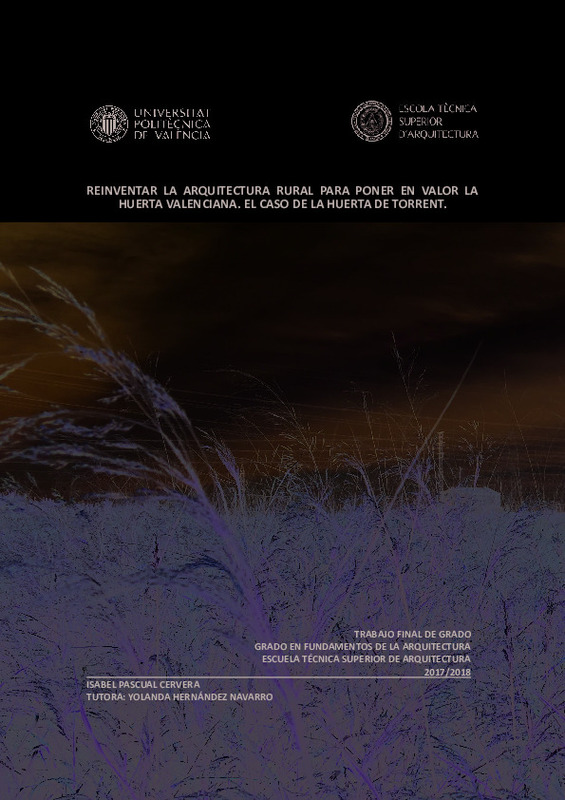|
Resumen:
|
[ES] Aunque la Huerta Valenciana, en la actualidad, pueda aparentar un paisaje idílico, la realidad descubre que cada vez más personas relacionadas con este ecosistema (labradores, empresarios del sector agrícola, habitantes, ...[+]
[ES] Aunque la Huerta Valenciana, en la actualidad, pueda aparentar un paisaje idílico, la realidad descubre que cada vez más personas relacionadas con este ecosistema (labradores, empresarios del sector agrícola, habitantes, etc.) se ven obligados a abandonar sus campos y sus casas y con ello sus actividades y sus costumbres. El abandono del medio rural a las ciudades supuso un gran cambio en la sociedad, hasta el punto en el que hoy en día vemos paisajes completamente abandonados, junto con ellos su patrimonio y ciertas actividades relacionadas con la naturaleza. Resulta paradójica la falta de aprecio hacia trabajos que satisfacen nuestras necesidades básicas. Tanto es así que actividades agrícolas tradicionales como recolectar, podar, poner en barbecho las tierras, etc., hoy son desconocidas para la nueva sociedad. La arquitectura tradicional ha sufrido, como consecuencia de esta situación, la pérdida de sus funciones, su consecuente abandono y deterioro, y en muchos casos su desaparición completa en ciertos municipios. Esto conlleva una gran pérdida de la propia cultura, de su historia y de la identidad de cada lugar. Revalorizar el paisaje rural que caracteriza a Valencia es la finalidad de este trabajo. Con ello se espera que cuando el foco de interés se haya puesto en el paisaje, empiece a cambiar poco a poco la mala situación en la que se encuentra. Generar ese sentimiento de aprecio, y por lo tanto, de preservación, haría que se valorara como es debido a las personas que luchan cada día por mantener el lugar, que se respetara el medio rural y que nos interesáramos por formar parte de él. Recuperar la arquitectura rural, y darle un nuevo significado, es la esencia de todo. La arquitectura como espacio rural re-inventado, puede ser un reclamo para la sociedad, tanto para las personas vinculadas al campo, como para las ajenas a él. Este patrimonio rural muestra, a través de su propia materia, toda la historia de cada lugar, a la vez, que su uso garantiza la regeneración de su entorno. Por lo tanto, reinventar la concepción de la Huerta, más allá de la percepción actual, relacionándola con otros ámbitos humanos como la educación, formación, ocio, etc., es el objetivo principal de este trabajo. Se ofrecen soluciones sostenibles simultáneamente desde tres aspectos: medioambiental, socio-cultural y económico. En concreto, se analiza la Huerta de Torrent con su arquitectura propia de masías, hoy en día muy deterioradas pero que por su cercanía a la ciudad presenta oportunidades de regeneración y desarrollo sencillas y sostenibles. Y se muestran modos de re-habitar zonas rurales extrapolables a otros lugares, animando, a otros municipios, a seguir el ejemplo de estas nuevas ideas.
[-]
[EN] Currently, although the Valencian orchard seems to be an idyllic landscape, the fact is that increasingly those people who are related with this ecosystem (Farmers, businessmen, inhabitants, etc.) are forced to abandon ...[+]
[EN] Currently, although the Valencian orchard seems to be an idyllic landscape, the fact is that increasingly those people who are related with this ecosystem (Farmers, businessmen, inhabitants, etc.) are forced to abandon their orchards, their houses and with it their activities and their traditions. Leaving the countryside to go to the cities was a big change in society, even nowadays we can see landscapes completely neglected, including their heritage and those activities related with nature.
It is paradoxical the lack of appreciation for jobs that satisfy our basic needs. So much so that agricultural activities such as picking, pruning or fallow fields are currently unknown for the new society. The traditional architecture has suffered, because of this situation, the loss of its functions, the state of being abandoned and deteriorated and in many cases the complete disappearance in some villages. This causes an important loss of one's own culture, its history and the identity of each place.
Revaluing the rural landscape that characterizes Valencia is the main purpose of this dissertation. With this, it is expected that the bad situation in which it is nowadays will change little by little when the focus of interest is on the landscape. Generating the feeling of appreciation, and therefore, of preservation, would make those people who work every day to maintain these places recognized as they worth and the rural environment more respected. Moreover, it would make us more interested to be part of it. Recovering the rural architecture, and giving it a new meaning, is the essence of everything. The architecture as a reinvented rural space can be a claim for the society, either people who are related to the rural area or those who are not related to it. This rural heritage shows, through its own material, the whole history of each place, at the same time, that its use guarantees the regeneration of its surroundings. Therefore, reinventing the Valencian orchard concept, beyond current perception, relating it to other human areas such as education, training, leisure, etc., is the main objective of this dissertation. Sustainable solutions are offered simultaneously from three aspects: environmental, sociocultural and economic. Torrent's orchard is analyzed with its own rural architecture, nowadays very deteriorated but, due to its proximity to the city, presents simple and sustainable opportunities for regeneration and development. Besides, there are shown ways to inhabit rural areas again that can be used in other places, encouraging other villages to follow these new ideas.
[-]
|








